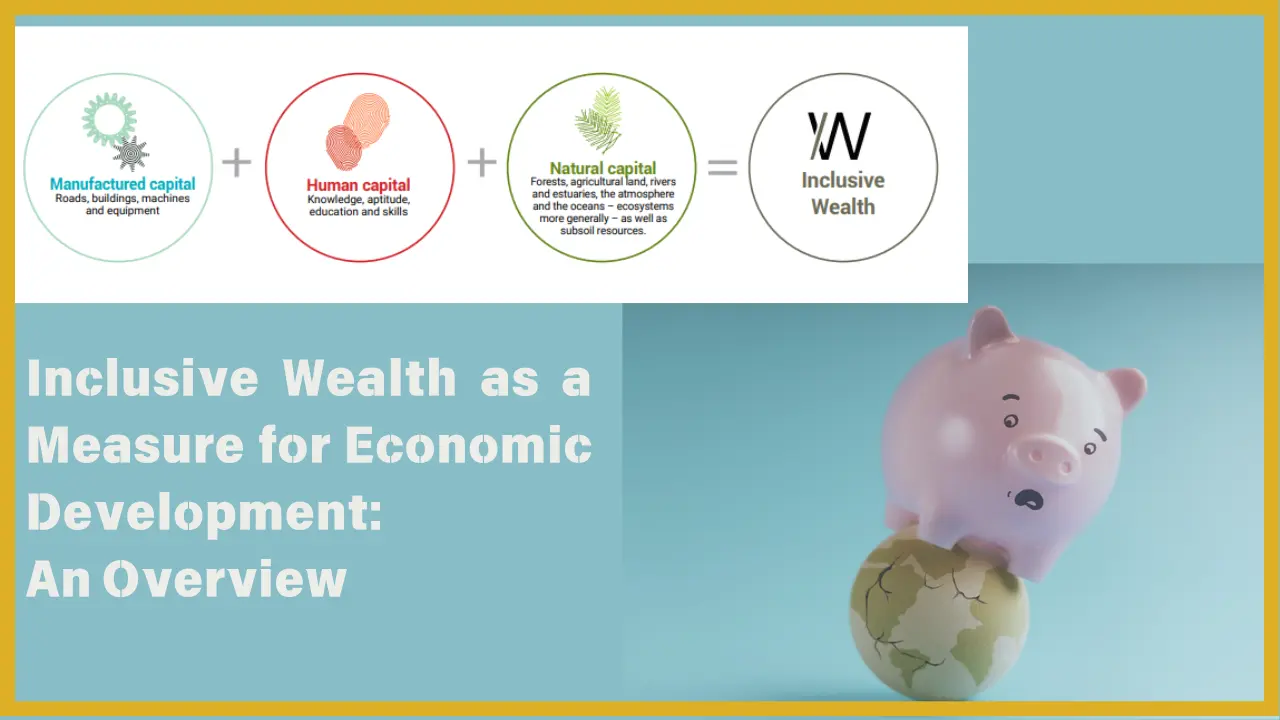![]() +91 60016-57575 |
+91 60016-57575 | ![]() info@takshashilascs.com
info@takshashilascs.com

Inclusive Wealth as a Measure for Economic Development: An Overview
Introduction:
The concept of Inclusive Wealth (IW), introduced by the United Nations Environment Programme (UNEP) and UNU-IHDP, takes into account a nation’s natural, human, social, and physical resources. This framework is particularly relevant to India, given its diverse socio-economic landscape, which necessitates a more holistic approach to assessing wealth.
According to the Global Wealth Index 2023, global inclusive wealth has surged by nearly 50% over the last three decades, indicating robust economic growth. However, this progress has come at the cost of significant depletion of natural capital, with over a quarter lost in this period, underscoring the need to balance economic growth with sustainable resource management.
1. What is Inclusive Wealth?
Inclusive Wealth represents a nation’s total wealth, which includes not only financial assets but also natural resources, human capital, and social capital.
1.1. Components of Inclusive Wealth
- Produced Capital: This includes tangible assets such as infrastructure, machinery, and technology. While traditional wealth measurements account for these assets, their sustainability and efficiency are increasingly recognized as vital for long-term economic well-being.
- Human Capital: This refers to the skills, knowledge, and health of the workforce. Investments in education, healthcare, and skill development enhance labour force productivity and adaptability, promoting economic resilience and growth. Strong human capital also fosters social networks, relationships, and community connections, which are essential for inclusive development.
- Social Capital: Social networks and relationships help build trust in institutions, promote better governance, and foster collaboration to solve problems.
- Natural Capital: This includes global stocks of natural assets like forests, water, minerals, and biodiversity. These resources provide ecosystem services that are crucial for human survival and economic activities.
Note: Social-Emotional Learning and Enhancing Human Capital
Social Emotional Learning (SEL) refers to the development of competencies necessary for recognizing and managing emotions, forming positive relationships, and making responsible decisions. SEL has a proven positive impact on a wide range of student outcomes, such as improved academic achievement, enhanced social skills, and better emotional well-being. It is argued that social and emotional competencies are essential components of human capital, as they boost productivity, improve task performance, and foster stable relationships, which contribute to favourable economic outcomes.
2. Why Adopt the Inclusive Wealth Approach (IWA)?
Limitations of Traditional Methods:
- GDP: While GDP measures overall economic output, it overlooks environmental degradation, the value of natural resources, and rising socio-economic inequalities. In India, GDP growth has reduced poverty but also caused significant environmental damage, costing around 5.7% of GDP annually.
- Green GDP: This metric adjusts GDP by subtracting environmental and social costs of development but still fails to account for crucial assets such as human capital or ecosystem health.
- Better Life Index: This index focuses on individual well-being rather than national statistics, but obtaining reliable personal data can be challenging in developing countries.
- Localized Approach: Given the diversity among Indian states, a localized method is necessary for assessing wealth in line with the Sustainable Development Goals (SDGs). The IWA, focusing on overall growth and requiring less data, is more suitable for developing countries with limited data access.
Read More Post : Exploring The New Trends in UPSC Question Papers
Long-term Sustainability Focus: The IWA allows for the assessment of long-term sustainability by considering changes in different types of capital. For instance, New Zealand’s Wellbeing Budget integrates social and environmental indicators alongside traditional economic metrics, prioritizing people’s well-being and environmental sustainability.
Better Resource Management: The IWA encourages better management of various forms of capital, particularly natural resources, which are often undervalued or ignored in conventional economic assessments. For example, Costa Rica’s Payments for Environmental Services Program (PES) financially supports forest conservation and combats land degradation.
Improved Policy Decisions: Understanding a nation’s wealth allows policymakers to make informed decisions about resource allocation, investment priorities, and growth strategies. South Korea’s Green New Deal, for example, focuses on clean energy, innovation, and sustainable infrastructure.
Additional Informations: Inclusive Wealth and the Welfare of Marginalized Communities
- Empowering Women: Recognizing the vital role of women, particularly in unpaid labour at home and in communities, enables the development of policies promoting gender equality and improving access to resources, in line with Article 15(3) of the Indian Constitution.
- Supporting Tribal Communities: Many tribal communities depend on natural resources for their livelihoods. The IWA ensures that their rights to land and resources are recognized and promotes sustainable practices that benefit both communities and the environment. For example, India’s Forest Rights Act (2006) empowers forest-dwelling tribes to manage their resources, preserve cultural heritage, and promote sustainability.
- Protecting Children: An inclusive wealth approach emphasizes the importance of investing in education, healthcare, and nutrition for children’s development. India’s Mid-Day Meal Scheme, for instance, supports health, education, and overall well-being, contributing to the nation’s future development.
- Recognizing Transgender Rights: The IWA promotes the inclusion of transgender individuals by addressing discrimination and recognizing their rights. The Transgender Persons (Protection of Rights) Act, 2019, aims to protect and legally recognize the rights of transgender people.
3. Challenges in Adopting the Inclusive Wealth Approach
Understanding the complexities and difficulties in measuring inclusive wealth is crucial to its successful implementation in modern economies.
3.1 Issues with Data Collection and Capacity
- Data Availability and Quality: Countries use different methods and definitions for data collection, resulting in inconsistencies. Many developing nations lack the necessary data on natural and social capital, hindering thorough assessments.
- Building Capacity for Data Collection: Establishing the institutional infrastructure to collect and analyze data on inclusive wealth requires significant investment and training.
- Dynamic Nature of Inclusive Wealth: Inclusive wealth evolves, making ongoing data collection necessary to track changes in capital.
3.2 Complexity of Assessing Inclusive Wealth
- Complexity of Components: Inclusive wealth includes diverse aspects—produced, natural, human, and social capital. Each has unique characteristics and methods of valuation, complicating the measurement process.
- Natural Capital Substitution: The idea that natural resources can be replaced by produced or human capital has led to their depletion. This imbalance prioritizes short-term economic growth over sustainability, making it difficult to assess inclusive wealth effectively.
3.3 Political Obstacles
- Integration with Current Economic Frameworks: The shift to inclusive wealth might face resistance from established economic practices, especially if current incentives focus on GDP growth.
- Lack of Political Will: The adoption of inclusive wealth requires strong political commitment, which may be lacking in contexts where GDP growth is prioritized.
3.4 Public Acceptance and Cultural Barriers
- Understanding Gap: Many people are unfamiliar with the concept of inclusive wealth, leading to confusion or resistance. Communicating its benefits effectively can be difficult in a context dominated by traditional metrics.
- Cultural Influence on Wealth Perception: Cultural values shape how wealth is perceived, and differences in economic development can lead to misleading comparisons if not properly explained.
4. Initiatives for Promoting the Inclusive Wealth Approach
Both national and global initiatives have been launched to foster the adoption of an inclusive wealth approach, integrating environmental, social, and economic factors in wealth assessments.
4.1 National-Level Initiatives
- Natural Capital Accounting: The Indian Ministry of Statistics and Programme Implementation (MOSPI) launched the NCAVES project in 2017, aligned with the SEEA framework to incorporate natural capital into economic assessments.
- National Mission for Green India: Part of India’s National Action Plan on Climate Change, focuses on increasing forest cover, enhancing the quality of ecosystems, and strengthening natural capital.
- Human Capital Development: Programs like Skill India and PMKVY enhance workforce skills, fostering economic resilience and productivity, thus contributing to inclusive wealth.
- SDG India Index: Developed by NITI Aayog, it tracks India’s progress toward the SDGs, which include key elements of inclusive wealth.
- International Partnerships: India collaborates with global organizations such as the World Bank and UNDP to enhance its ability to measure inclusive wealth.
4.2 Global Initiatives
- UN SEEA Framework: A global framework integrating economic and environmental data, offering countries a standardized approach to measure the relationship between the economy and the environment.
- TEEB Initiative: This global effort emphasizes the economic value of biodiversity and the costs of ecosystem degradation.
- UN Inclusive Wealth Report: Released by UNEP, this report assesses countries’ wealth by considering natural, human, and produced capital.
- World Bank WAVES Initiative: This initiative helps countries adopt Natural Capital Accounting, promoting sustainable development by incorporating natural resources into development planning.
- EU’s Beyond GDP Initiative: This encourages EU member states to adopt measures of progress that go beyond traditional economic indicators.
- Global IWI Project: A joint initiative by UN University and UNEP, this project aims to offer a broader measure of national wealth by evaluating natural, human, and produced capital, focusing on sustainability.
- GPI (Genuine Progress Indicator): An alternative to GDP, the GPI incorporates environmental and social factors for a more comprehensive view of economic well-being.
- Natural Capital Protocol: This framework helps businesses assess their impacts on natural capital in a standardized way.
Additional Points: Inclusive Wealth and SDG Fulfillment
- Produced Capital’s Role: Strategic investments in infrastructure can advance goals related to climate, energy, water, transport, and technology. Public infrastructure also helps reduce violence against women by creating safer environments.
- Natural Capital’s Role: The Inclusive Wealth Approach promotes sustainable resource management, supporting SDGs related to marine and terrestrial ecosystems. It also emphasizes intergenerational equity, aligning with SDGs on responsible consumption and climate action.
- Human Capital’s Role: Focusing on equity and social inclusion, the Inclusive Wealth Approach supports SDGs related to reducing inequalities and gender equality. Investments in education, health, and skills align with SDGs on quality education and good health.
5. Steps for Ensuring the Adoption of the Inclusive Wealth Approach
Studies highlight various measures for adopting the inclusive wealth approach, incorporating environmental, social, and economic factors in national wealth assessments.
5.1 Policy Initiatives
- Policy Integration: Integrate the Inclusive Wealth framework into national and state policies to complement existing frameworks like GDP and the SDGs. Examples include replacing fossil fuel subsidies with greener alternatives and improving resource revenue management.
- Align Investments with Natural Capital: Governments should connect investment strategies to natural capital, focusing on ESG criteria to enhance resilience.
- Pilot Programs: Begin with small-scale pilot projects to test the Inclusive Wealth framework, gathering insights for broader applications.
5.2 Assessment Initiatives
- Localized Wealth Assessment: Develop regional IW measures to monitor progress in natural, human, and produced capital, allowing policies to address regional disparities. Expanding MOSPI’s green wealth accounting can aid this effort.
- Consider Population Growth: Wealth assessments should consider future demographic changes to ensure intergenerational welfare.
- Human Capital Accounting: Incorporate human capital metrics to address health and education challenges, identify inequalities, and create policies that promote well-being.
- Research and Development: Conduct studies on the interactions between different types of capital to refine policies and initiatives.
5.3 Leveraging Data and Technology
- Assessing Progress through Indicators: Develop indicators to track progress across different capital types, using real-time data for policy refinement.
- Ecosystem Services for Sustainability: Invest in better data and technology to improve the valuation and management of ecosystems, ensuring long-term prosperity.
5.4 Engagement and Capacity Building
- Stakeholder Engagement: Involve marginalized communities in wealth assessment discussions to ensure policies reflect the needs of all segments of society.
- Capacity Building and Education: Train government officials, economists, and community leaders on the Inclusive Wealth framework to enhance understanding of sustainability.
- Awareness Campaigns: Educate the public about the Inclusive Wealth approach and its role in sustainable development, generating support for a shift away from GDP-centric measures.
Conclusion
Adopting the Inclusive Wealth approach is essential for sustainable economic development that prioritizes well-being. By integrating natural, human, social, and produced capital, this framework provides a holistic view of prosperity, which is particularly relevant for countries like India, where inequalities are pronounced. It offers a pathway for policies that empower marginalized communities, ensure fair resource management, and promote long-term sustainability.







